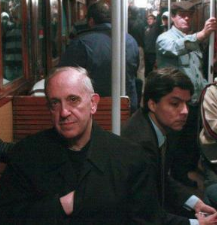The Last Words of Bergoglio before the Conclave
By Sandro Magister
His words made an impression on many. Bergoglio spoke off the cuff. But we now have the account of those words of his, written by the hand of the author himself. Bergoglio's remarks in the preconclave were made public by the cardinal of Havana, Jaime Lucas Ortega y Alamino, in the homily of the chrism Mass that he celebrated on Saturday, March 23 in the cathedral of the capital of Cuba, in the presence of the apostolic nuncio, Archbishop Bruno Musaro, of the auxiliary bishops Alfredo Petit and Juan de Dios Hernandez, and of the clergy of the diocese. Cardinal Ortega recounted that after the remarks of Bergoglio in the preconclave, he had approached him to ask if he had a written text that he could keep. Bergoglio responded that at the moment he did not have one. But the following day - Ortega recounted - "with extreme delicacy” he gave him “the remarks written in his own hand as he recalled them." Ortega asked him if he could release the text, and Bergoglio said yes. The cardinal of Havana renewed the request on March 13 after the end of the conclave, when the archbishop of Buenos Aires had been elected to the chair of Peter. And Pope Francis renewed his authorization. So on March 26, the photocopy of Bergoglio's manuscript and its transcription in Spanish appeared on the website of “Palabra Nueva," the magazine of the archdiocese of Havana. Bergoglio's notes are presented in their entirety further below. In them can be recognized some recurrent traits in his initial preaching as pope. “Spiritual worldliness” as “the worst evil of the Church.” The Church's duty to “come out from itself” in order to evangelize the “peripheries, not only geographical, but existential.” As on other occasions, here as well Bergoglio borrows the expression “spiritual worldliness” from the Jesuit Henri De Lubac, one of the greatest theologians of the twentieth century, made a cardinal in his later years by John Paul II. In his book “Meditations on the Church,” De Lubac defines spiritual worldliness as “the greatest danger, the most perfidious temptation, that which always reemerges insidiously when all the others have been overcome, even being fostered by these same victories.” And he continues: "If this spiritual worldliness were to invade the Church and work to corrupt it by attacking it at its very origin, this would be infinitely more disastrous than any other sort of simply moral worldliness. Even worse than the infamous leprosy that, in certain moments of history, has so cruelly disfigured the beloved Bride [the Church - editor's note] when gratification seemed to bring the scandal into her very sanctuary and, represented by a libertine pope, has obscured the face of Christ under precious stones, makeup and beauty marks. . . A subtle humanism inimical to the living God - and, in secret, no less inimical to man - can establish itself in us through a thousand subterfuges." This citation from De Lubac is in evidence in an article that Bergoglio wrote in 1991 when he was an ordinary Jesuit priest, republished and given in 2005 to the faithful and to the citizens of Buenos Aires, of which he had become archbishop, and now reappears in the first of the books printed in Italy with the texts of the new pope from before his election, entitled: “Guarire dalla corruzione." Another significant citation in the notes by Bergoglio is where he points out the dangers to the Church when it ceases to be “mysterium lunae." The "mystery of the moon” is a formula that the Fathers of the Church repeatedly used beginning in the second century to suggest what might be the true nature of the Church and the action that is appropriate to it: like the moon, “the Church shines not with its own light, but with that of Christ” ("fulget Ecclesia non suo sed Christi lumine"), St. Ambrose says. While for Cyril of Alexandria, “the Church is enveloped in the divine light of Christ, which is the only light in the kingdom of souls. There is therefore a single light: in this one light nonetheless shines also the Church, which is not however Christ himself.” On this theme and with the title of “Mysterium lunae" a fundamental book was written in 1939 by another Jesuit, Hugo Rahner, a distinguished patrologist.
|
.
Any original material on these pages is copyright © BishopAccountability.org 2004. Reproduce freely with attribution.
